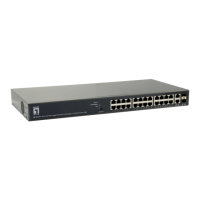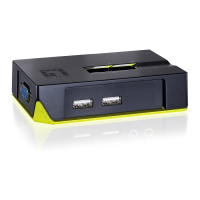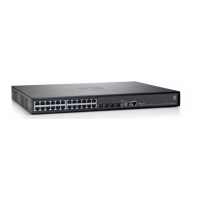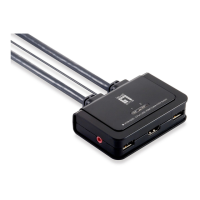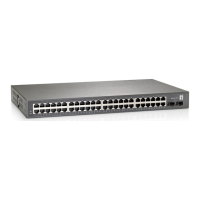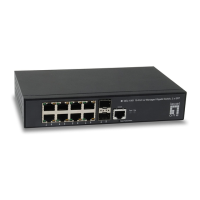Do you have a question about the LevelOne ProCon GSW-2476 and is the answer not in the manual?
Provides a general introduction to the LevelOne GSW-2476 switch.
Explains the switch's wire-speed, non-blocking switching fabric.
Describes the use of LEDs and embedded management software for monitoring.
Details the physical components, ports, and status indicators of the switch.
Highlights key features like connectivity, expandability, performance, and management.
Covers SFP slots, Jumbo frames, flow control, and management interface features.
Explains the function, benefits, and concepts of network switches.
Introduces common network configurations using the switch.
Provides important notes on full-duplex, routing, and fiber optic cable lengths.
Guides on choosing an appropriate location for the switch installation.
Details criteria for suitable Ethernet cables for network operation.
Lists package contents and covers initial mounting considerations.
Details factors and steps for mounting the switch in a rack.
Explains how to attach adhesive feet and place the switch on a flat surface.
Guides on how to insert SFP transceivers into the switch slots.
Details the procedure for connecting the switch to an AC power source.
Introduces connecting the switch to various network devices.
Specifies cable requirements and guidelines for twisted-pair connections.
Describes connections within a wiring closet using patch panels.
Details the use and connection of Gigabit SFP transceivers.
Lists rules for network connectivity, including cable types and lengths.
Provides guidelines for labeling cables and keeping connection records.
Introduces the embedded web agent for switch configuration.
Explains how to access and log in to the switch's web interface.
Describes the layout of the switch's home page and panel indicators.
Lists and describes the main menu sections for switch management.
Covers viewing system information, status, and name.
Details displaying port statistics and configuring individual ports.
Guides on configuring the IP interface and manual network settings.
Covers configuring the logon password and general security.
Explains tools for reset, upgrade, upload/download, and boot image.
Explains how to manage static MAC addresses for ports.
Details features for network protection and traffic monitoring.
Guides on performing cable diagnostics to identify faults.
Explains how to create trunks and configure trunk settings.
Details how to create, manage, and configure VLANs and membership.
Explains Quality of Service settings for prioritizing network traffic.
Introduces security features including Access Control Lists (ACLs).
Explains IGMP Snooping for filtering multicast traffic and its configuration.
Provides a troubleshooting chart for power and link LEDs.
Addresses issues related to the switch's power indicator and cooling.
Covers installation problems and in-band access troubleshooting.
Provides a step-by-step guide to reset the switch to default settings.
Details the wiring and pin assignments for twisted-pair cables.
Shows MDI and MDI-X port pinouts for 10/100BASE-TX connections.
Illustrates wiring diagrams for straight-through and crossover cables.
Details MDI and MDI-X port pinouts for 1000BASE-T connections.
Covers testing and adjusting Category 5 cables for 1000BASE-T.
Describes recognized optical fiber cable types for subsystems.
Lists physical attributes like ports, network interface, and weight.
Details size, temperature, humidity, AC input, and power consumption.
Outlines forwarding mode, throughput, and management features.
Lists software loading methods, supported standards, and compliances.
Defines key networking terms such as 1000BASE-T, Auto-Negotiation, Ethernet, and VLAN.
Provides an alphabetical and numerical index for navigating the manual's content.
Provides a general introduction to the LevelOne GSW-2476 switch.
Explains the switch's wire-speed, non-blocking switching fabric.
Describes the use of LEDs and embedded management software for monitoring.
Details the physical components, ports, and status indicators of the switch.
Highlights key features like connectivity, expandability, performance, and management.
Covers SFP slots, Jumbo frames, flow control, and management interface features.
Explains the function, benefits, and concepts of network switches.
Introduces common network configurations using the switch.
Provides important notes on full-duplex, routing, and fiber optic cable lengths.
Guides on choosing an appropriate location for the switch installation.
Details criteria for suitable Ethernet cables for network operation.
Lists package contents and covers initial mounting considerations.
Details factors and steps for mounting the switch in a rack.
Explains how to attach adhesive feet and place the switch on a flat surface.
Guides on how to insert SFP transceivers into the switch slots.
Details the procedure for connecting the switch to an AC power source.
Introduces connecting the switch to various network devices.
Specifies cable requirements and guidelines for twisted-pair connections.
Describes connections within a wiring closet using patch panels.
Details the use and connection of Gigabit SFP transceivers.
Lists rules for network connectivity, including cable types and lengths.
Provides guidelines for labeling cables and keeping connection records.
Introduces the embedded web agent for switch configuration.
Explains how to access and log in to the switch's web interface.
Describes the layout of the switch's home page and panel indicators.
Lists and describes the main menu sections for switch management.
Covers viewing system information, status, and name.
Details displaying port statistics and configuring individual ports.
Guides on configuring the IP interface and manual network settings.
Covers configuring the logon password and general security.
Explains tools for reset, upgrade, upload/download, and boot image.
Explains how to manage static MAC addresses for ports.
Details features for network protection and traffic monitoring.
Guides on performing cable diagnostics to identify faults.
Explains how to create trunks and configure trunk settings.
Details how to create, manage, and configure VLANs and membership.
Explains Quality of Service settings for prioritizing network traffic.
Introduces security features including Access Control Lists (ACLs).
Explains IGMP Snooping for filtering multicast traffic and its configuration.
Provides a troubleshooting chart for power and link LEDs.
Addresses issues related to the switch's power indicator and cooling.
Covers installation problems and in-band access troubleshooting.
Provides a step-by-step guide to reset the switch to default settings.
Details the wiring and pin assignments for twisted-pair cables.
Shows MDI and MDI-X port pinouts for 10/100BASE-TX connections.
Illustrates wiring diagrams for straight-through and crossover cables.
Details MDI and MDI-X port pinouts for 1000BASE-T connections.
Covers testing and adjusting Category 5 cables for 1000BASE-T.
Describes recognized optical fiber cable types for subsystems.
Lists physical attributes like ports, network interface, and weight.
Details size, temperature, humidity, AC input, and power consumption.
Outlines forwarding mode, throughput, and management features.
Lists software loading methods, supported standards, and compliances.
Defines key networking terms such as 1000BASE-T, Auto-Negotiation, Ethernet, and VLAN.
Provides an alphabetical and numerical index for navigating the manual's content.
| Switching Capacity | 52 Gbps |
|---|---|
| MAC Address Table Size | 8K |
| Jumbo Frame Support | 9KB |
| Power Supply | 100-240V AC, 50/60Hz |
| Operating Temperature | 0°C to 40°C |
| Storage Temperature | -40°C to 70°C |
| Humidity | 10% to 90% non-condensing |
| Ports | 24 x 10/100/1000BASE-T RJ-45, 4 x 1000BASE-X SFP |


